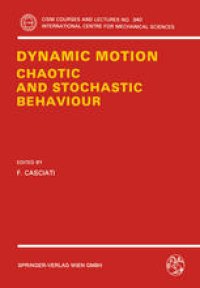
Ebook: Dynamic Motion: Chaotic and Stochastic Behaviour
Author: F. Casciati (eds.)
- Tags: Mechanical Engineering, Mechanics, Civil Engineering, Appl.Mathematics/Computational Methods of Engineering, Simulation and Modeling, Theoretical and Applied Mechanics
- Series: International Centre for Mechanical Sciences 340
- Year: 1993
- Publisher: Springer-Verlag Wien
- Edition: 1
- Language: English
- pdf
The chapters of this book were written by structural engineers. The approach, therefore, is not aiming toward a scientific modelling of the response but to the definition of engineering procedures for detecting and avoiding undesired phenomena. In this sense chaotic and stochastic behaviour can be tackled in a similar manner. This aspect is illustrated in Chapter 1. Chapters 2 and 3 are entirely devoted to Stochastic Dynamics and cover single-degree-of-freedom systems and impact problems, respectively. Chapter 4 provides details on the numerical tools necessary for evaluating the main indexes useful for the classification of the motion and for estimating the response probability density function. Chapter 5 gives an overview of random vibration methods for linear and nonlinear multi-degree-of-freedom systems. The randomness of the material characteristics and the relevant stochastic models ar considered in Chapter 6. Chapter 7, eventually, deals with large engineering sytems under stochastic excitation and allows for the stochastic nature of the mechanical and geometrical properties.
The chapters of this book were written by structural engineers. The approach, therefore, is not aiming toward a scientific modelling of the response but to the definition of engineering procedures for detecting and avoiding undesired phenomena. In this sense chaotic and stochastic behaviour can be tackled in a similar manner. This aspect is illustrated in Chapter 1. Chapters 2 and 3 are entirely devoted to Stochastic Dynamics and cover single-degree-of-freedom systems and impact problems, respectively. Chapter 4 provides details on the numerical tools necessary for evaluating the main indexes useful for the classification of the motion and for estimating the response probability density function. Chapter 5 gives an overview of random vibration methods for linear and nonlinear multi-degree-of-freedom systems. The randomness of the material characteristics and the relevant stochastic models ar considered in Chapter 6. Chapter 7, eventually, deals with large engineering sytems under stochastic excitation and allows for the stochastic nature of the mechanical and geometrical properties.